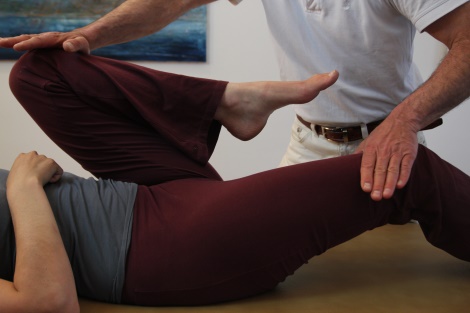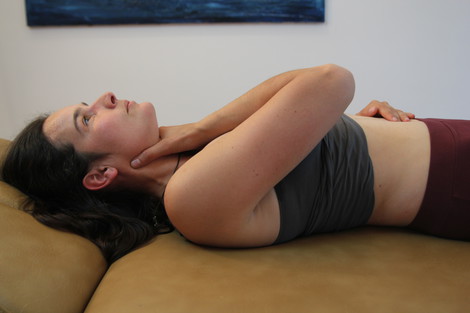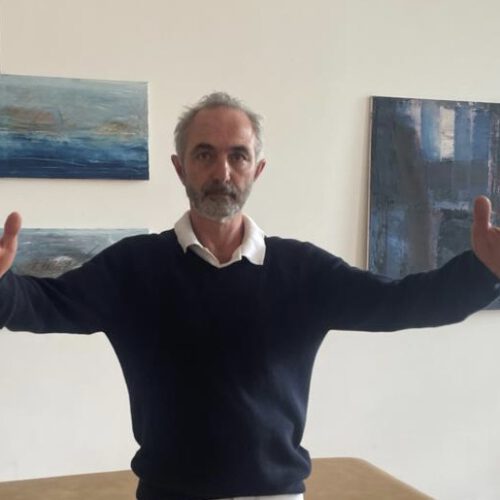Pelvic distortion as a sign for a fixed stress mode and it’s treatment ( summary and overview)
1. causes and effects
Pelvic distorsion means a twisting of the two halves of the pelvis against each other. In most cases, the left ilium is twisted forwards, combined with tension in the left hip flexor (iliopsoas) and the right ilium is twisted backwards with tension in the hip extensors (adductors) and the back extensor (quadratus lumborum).
This is usually associated with a slight twisting of the whole body.
The corkscrew-like curvature of the spine, often with functional leg length discrepancy, can affect all organs and regions supplied by the spine.
The orthopaedic symptoms can range from head and neck pain with dizziness, visual disturbances, tinnitus, shoulder and arm pain, cardiac arrhythmia, a feeling of tightness in the chest, upper or lower abdominal discomfort to acute and chronic back, pelvic and leg pain.
The typical initial pain in the back in the morning or after prolonged sitting often disappears with improved blood circulation in the cramped muscles through movement and warmth.
Strain pain usually increases with poor posture, especially when sitting or standing for long periods and frequent bending and heavy lifting.
Children often have less orthopaedic than mental complaints because of the tension in their nervous system and a correlated torsion of the first vertebra, the atlas. They mostly develop back pain and headaches from puberty onwards and keep it life long without adequate causal treatment.
The short-term twisting of the pelvis in the sense of an attack or defense position contributed in our prehistory to our ability to react quickly in the event of sudden danger. When the body and psyche relaxed after the physical high performance with the consumption of stress hormones, the pelvis usually relaxed again. If the stress hormones remain because either the physical activity after a stressful situation or sufficient relaxation is lacking, the pelvis also remains twisted.
In my opinion, the cause of a fixed pelvic rotation is always some form of excessive physical and/or mental stress, so-called disstress with an insufficient recovery phase.
The decompensation of the regulatory forces of body and psyche leads to a blockage of our relaxation and regeneration nerves, the vagus.
However, the persistent stress state of the autonomic nervous system and the fascial system does not only have consequences for the musculoskeletal system. The function of all other organs, the immune system and the psyche can also suffer. We often notice this in a variety of vegetative complaints such as increasing poor performance, sleep disorders, listlessness and a decrease in libido.
Poor posture, weak muscles or shortened and thickened tendons can reduce our resilience to external stress factors. But our systems collaps mostly because of additional internal causes of stress.
Physical and psychological trauma or the consequences of illness, like scars, can act as a source of interference in our body or as an interference or trauma field in it’s energetic field and not only reduce our resilience to any kind of further stress but also reduce our physical and emotional vibration abilty.
With the integral stress test a fixation of our nervous system can easily be diagnosed and with the integration techniquesi nternal and external causes of stress can be identified and released.
Patients learn to relax their systems regularly and before and after an overload.
Ortho-bionomic exercises are shown to treat the consequential damage to the musculoskeletal system caused by pelvic twisting in order to gradually dissolve chronic shortening and tension in the fascial network and to release acute joint blockages as directly as possible.
2. examination of the pelvic twisting
Hip flexors (iliopsoas): While lying down, pull both knees to your chest one after the other.A shortening can be seen by lifting the extended leg (usually on the left) when the opposite knee is pulled towards the chest.
Hip extensors (adductors): While lying down, place both feet on the floor with hips and knees bent and let both knees fall outwards one after the other. Hold the opposite side of the pelvis with one hand.
On the side of the shortened adductors (usually on the right), the abduction of the flexed hip is reduced.


3. the integral stress test
Touching the navel, the front of the neck or an active interference focus usually releases the pelvic curvature directly
If this is not the case, there is usually an energetic interference field at the navel and neck due to psychic stress stored in the aura.
If the pelvic torsion does not dissolve when the scars are touched, there is either no disturbance or there is also a superordinate energetic interference field, the relief of which then leads directly to pelvic relaxation.
If the pelvic torsion is released when touching key areas such as the atlas, the coccyx and the SI joint region, the jaw or the eyes, this indicates a causal relationship to the stress state of the pelvic torsion.
Carrying out the test
1. foreign body:
Jewelry: Remove any jewelry, possibly earrings, always an umbilical piercing ! and check the pelvis.
Dental splints: It is best to test your bite splint at the beginning and then again at the end of your self-treatment with regard to the pelvis.
Frequent sources of interference and stress zones:
Touch the following regions one after the other and test the pelvis each time.
Front neck: tonsil scars, thyroid gland, vagus
Flank: Adrenal glands, kidneys, solar plexus, vagus plexus in the upper abdomen, solar plexus, diaphragm, abdominal and back fasciae, quadratus lumborum, 12th rib SI joint.
Scars: Don’t forget wisdom teeth or nasal septum, perineal scar and deep scars. The latter are tested by shifting attention.
Eyes interfere with overuse or after opus etc.
Key joints: temporomandibular joints, head joints with the atlas, SIJ, coccyx, tarsal joints.
Energetic interference fields
Energetically disruptive scars
Energetically disruptive fascial key zones, such as the atlas, flank
chakras
4.Treatment
The navel and neck integration and ideally also the aura release in the neck and abdominal area should be applied daily and, in the case of a lot of stress or corresponding complaints, several times a day. In the case of scars, repeated, initial treatment is usually sufficient, as well as renewed treatment in the event of reactivation due to excessive stress.
1st navel integration
The task of the umbilical hand:
One hand lies relaxed on the abdomen and, with the middle finger in the navel, pushes the navel very gently, a very little, in the direction with the least resistance, which is also the most comfortable and produces a deep breath.
The task of the second hand:
Front neck grip

Flank grip
The palm of the hand lies behind on the deep lumbar muscle (quadratus lumborum) and the large fascia of the back as well as the kidneys and adrenal glands between the ribs and pelvis, especially if the kidney region feels cold and is sensitive to cold.

2. scar integration:
Disturbing scars are touched very gently with the fingertips in a pleasant direction. Deep scars, such as after a tonsillectomy or perineal tear or in the peritoneum after an appendectomy or caesarean section, can also be removed in this way by placing the second hand on them for a longer period of time and shifting attention to the depth of the scar
3. integration of pain zones:
The second hand lies on a region of tension or pain
4. aura relief:
Interference field neck and abdomen
Both hands are spread wide apart, first in front of the abdomen and then in front of the neck, and come a little closer together as if they were trying to grasp a large ball or a cloud. Stay just outside the limit where a slightly uncomfortable atmosphere builds up and your arms become heavy. Wait until the cloud of stress dissipates.
In the case of large stress or trauma fields, this reaction may not occur because your arms cannot embrace the stress cloud. In this case, your partner will slowly approach you from a great distance with his or her flat hand pointing towards your neck or stomach. When you no longer feel his/her hand as unpleasant, but just perceive it, the partner opens the interference field by turning him/herself and the arm outwards. Together with the outflowing tension, the suppressed emotions responsible for this are released either directly or gradually.

Interference field scars
Self-treatment: the second hand, held at a slight angle, lingers at a greater distance above an area of tension, for example a scar or an area of pain, until the tension subsides
Partner treatment: Depending on the trauma, the distance that is still perceived as unpleasant during aura or interference field relief can be many meters. Take enough time and space for any emotions that may be released D
Interference field scars
You can test these by concentrating your fingers in depth and treat them in connection with the navel.
Treatment of the pelvic joints and a irritation of the dorsal vagus
The affected joints, in particular the pubic symphysis and the SI joint region, are relieved ortho-bionomically in the free direction. The higher pubic bone is pushed a little higher. The forward-rotated pelvic blade on the side of the shortened hip flexor is pushed a little further forward. The rotated pelvic blade on the side of the shortened adductors is pushed backwards or lifted slightly in the prone position. The sacrum is pushed in a comfortable direction, if necessary with simultaneous pressure on the coccyx.
A pain on the coccyx often is a sign for a blockade of the dorsal vagus nerve, caused by overwhelming stress and trauma. How to treat this and the whole back you can read under sacrum integration.
More information you can find under pelvic distortion long version.
